World Travel Awards Winner
Endorsed by ASTA
In Alliance with Regenera
Rated Excellent by Tripadvisor
Located 1000 kilometers south of Lima at an altitude of 2,225 meters, Arequipa is considered, the second most important city in Peru. It was founded by the Spanish on August 15th, 1540 under the orders of Garci Manuel de Carbajal, one of Pizarro’s lieutenants, in the valley of the Chili River, and it was named “Villa Hermosa de Arequipa”. A year later it was granted the status of a city through a royal decree issued on October 7th, 1541 by Carlos V of Spain.
The name Arequipa is the result of a combination of two words: “Are” and “quipa”. It may have been derived from the Quechua words “ari”, which means “yes”, and “quipay”, which means “stay”. On the other hand, in the Aymara language “ari” means “peak”, while “quipay” means “behind”, thereby producing the phrase “behind the peak” in reference to Arequipa’s location at the foot of El Misti volcano.
After its foundation, Arequipa was immediately inhabited by Spanish conquistadores and colonists and it quickly became the highest concentration of Hispanic inhabitants in the Viceroyalty of Peru. It was built using the white volcanic rock known as Sillar, which is common in this volcanic region, and it is known as the White City.
Currently, its historic center with colonial and republican European-style buildings, in addition to its charming squares and streets, is widely visited by tourists. In addition to its colonial convent of Santa Catalina, where you can see the way of life of the Peruvian nuns in the colonial era. Its regional gastronomy deserves a particular mention.
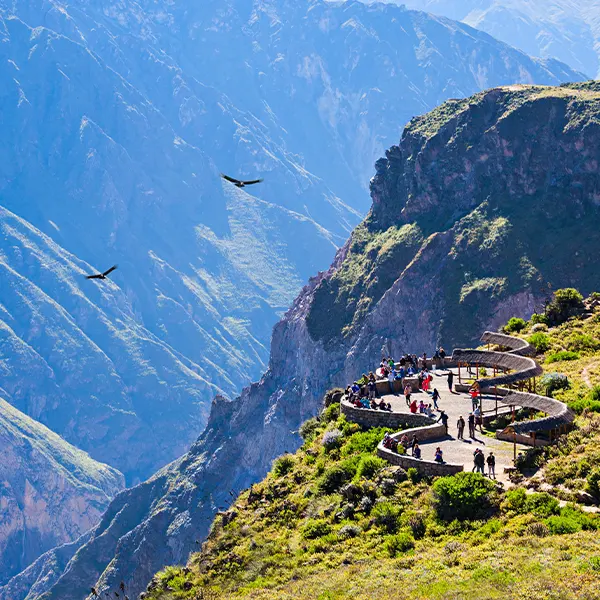
11 Days / 10 Nights
Lima, Arequipa, Colca Canyon, Puno, Lake Titicaca, Cusco, Sacred Valley, Machu Picchu
Arrowheads and rock art have proven human occupation around Arequipa for over ten thousand years. This began with early groups of hunter-gatherers arriving here on a seasonal basis for several millennia from 8000 BC to around 1000 BC when horticulture and ceramic technology began to appear in small settlements along streams and rivers. Initially influenced by the Paracas culture and later by the Tiahuanaco-I Huari, two major local tribes emerged sharing the area: the Churajone living in the far northwest section of the Arequipa region, and the Chuquibamba who thrived higher up in the Andean plateaus above Arequipa unt.il the arrival of the Incas.
The name Arequipa is derived from the Quechua phrase "art quepay", meaning "let's stop here, which, according to local legend, is exactly what the fourth Inca emperor, Mayta Capac, said to his generals on the way through the area following one of his conquest trips.
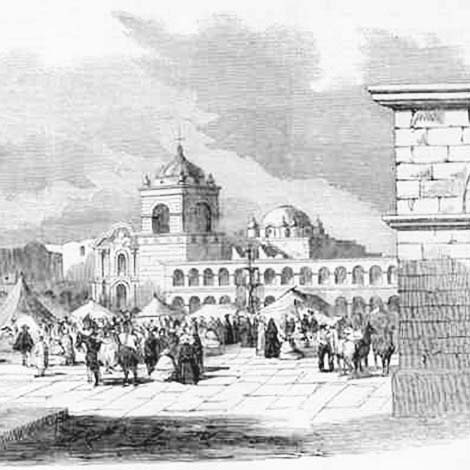
The Incas were not alone in finding Arequipa to their liking. When Pizarro officially "founded" the city in 1540, he was moved enough to call it Villa Hermosa, or Beautiful Town, and Don Quixote author Miguel de Cervantes extolled the city's virtues, saying that it enjoyed an eternal springtime. The lovely white stone lent itself to extravagant buildings and attracted master architects to the city.
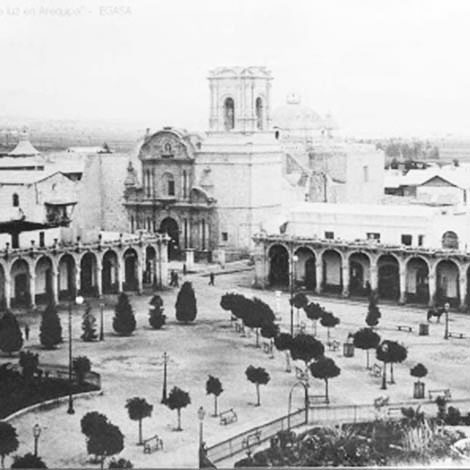
During the eighteenth and nineteenth centuries, this mountainous region became an important source of sheep and alpaca wool exports, largely to the UK. Connected to the rest of Peru only by mule track until 1870, Arequipa was slow to become the provincial capital it is today. Money made mainly from exports kept the economy growing enough to establish an electric urban tramway in 1913 and then a road up to Puno in 1928.
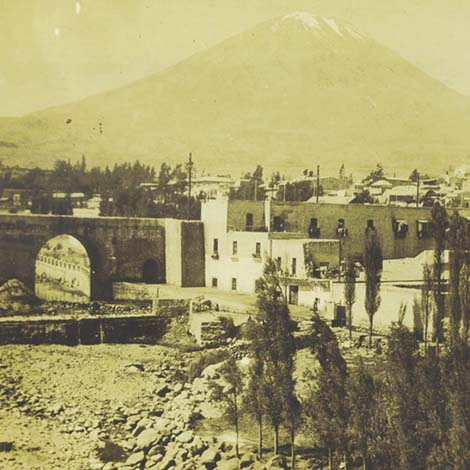
Having acquired a reputation as the center of right-wing political power, while populist movements have tended to emerge around Trujillo in the north, Arequipa has traditionally represented the solid interests of the oligarchy. Important politicos, like Francisco Javier de Luna Pizarro, who was president of Congress on many occasions in the nineteenth century, came from Arequipa. Sánchez Cerro and Odria both began their coups here, in 1930 and 1948 respectively, and Belaunde, one of the most important presidents in pre- and post-military coup years, sprang into politics from one of the wealthy Arequipa families. By 1972 the city's population had reached 350,000. Twenty years later it passed half a million, with many people arriving from the Andean hinterland to escape the violence of Peru's civil war.
The social extremes are quite clear today; despite the tastefully ostentatious architecture and generally well-heeled appearance of most townsfolk, there is much poverty in the region and there's been a huge increase in the number of street beggars in Arequipa. Social polarization carne to a head in 2002, when the city's streets were ripped up in political protest against President Toledo´s plans to sell off the local electric utility.
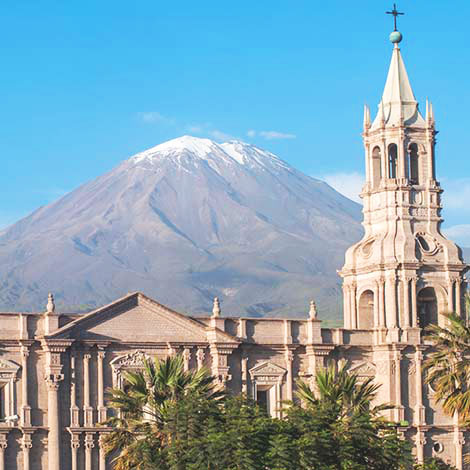
Arequipa is the 3rd city of Peru, behind Lima and Trujillo. At an altitude of 2335 meters above sea level and is lower than Cusco, Puno and the nearby Colca Canyon.
The city often experience small earthquakes and sometimes volcanic eruptions from the nearby active volcanos.
There are three volcanos that tower over Arequipa city: Chanchani (19939 feet), Misti (19101 feet) and Pichu Pichu (18599 feet). Misti is the only active volcano but is currently dormant, the volcano has a history of large eruptions.
Cotahuasi Canyon, is the deepest in the world and is located in the Valley of the Volcanoes. With a depth of 11000 feet it is much deeper than the Grand Canyon at 6093 feet.
Colca Canyon is not as deep as Cotahuasi but is more a destination for tourists with tours to the Canyon daily from Arequipa. You may also book a 2 or 3 day trek to get a greater view of the canyon.
Arequipa has some of the best weather in all of Peru, and has an average of 300 sunny day every year. The sun can sometimes be harsh so remember to take precautions. Located close to the desert you can expect to experience strong sun during the day and cooler weather at night.
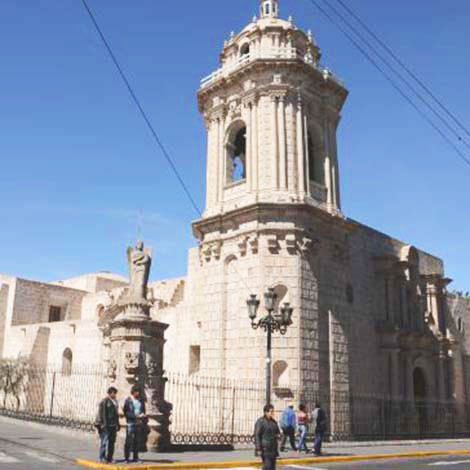
East of the Iglesia La Compañía and the plaza you'll find the exquisitely restored Iglesia Santo Domingo, originally built in 1553 by Gaspar Baez, the first master architect to arrive, in Arequipa. Most of what you see today was built between 1650 and 1698, but suffered major damage during the earthquakes of 1958 and 1960. The large main door represents m interesting example of Arequipas mestizo craftsmanship - an Indian face amid a bunch of grapes, leaves, and cacti - and the side door is said to be the oldest in the city.
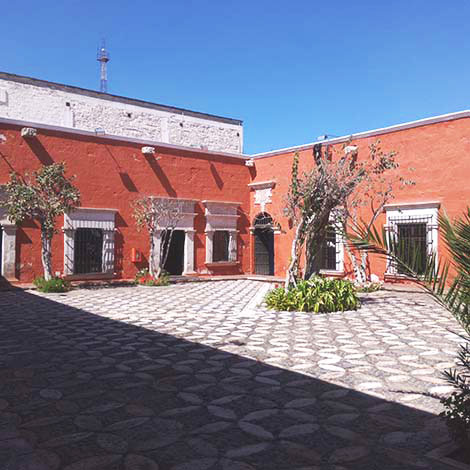
Around the corner from the Casa Arróspide sits the seventeenth-century La Casa del Moral (literally meaning "Mulberry House"), lovingly restored and refurbished with period pieces. Its most engaging feature is a superb stone gateway, carved with motifs that are similar to those on Nasca ceramics - puma heads with snakes growing from their mouths - surrounding a Spanish coat of arms. The mansion's name comes from an ancient mora trece, still thriving in the central patio.
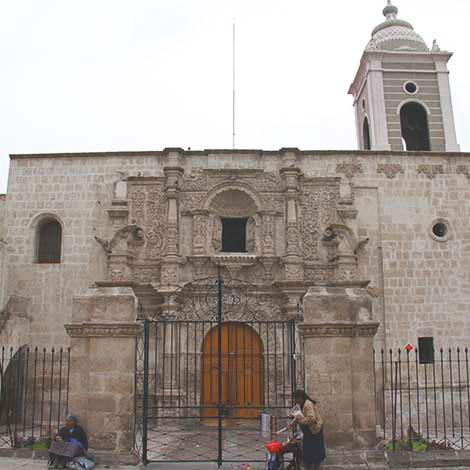
One block from the Casa del Moral, the elegant 1575 Iglesia San Agustín has one of the. city's finest Baroque facades, added later in the late eighteenth century. Its old convent cloisters are now attached to the university, while inside only my unique octagonal sacristy survived the 1868 earthquake.
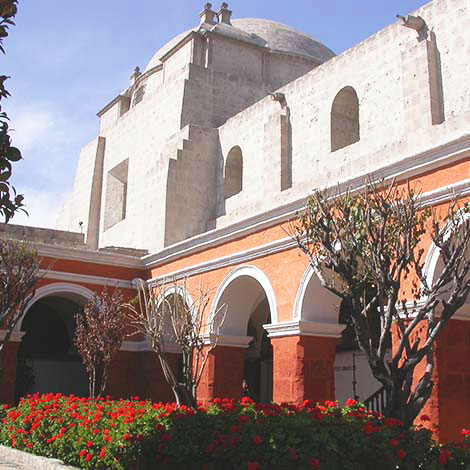
Two blocks north of the Plaza de Armas the vast walls of the Monasterio de Santa Catalina shelter a convent that housed almost two hundred secluded nuns and three hundred servants from the late sixteenth century until 1970, when it opened some of its outer doors to the public. The most important and prestigious religious building in Peru, its enormous complex of rooms, cloisters, and tiny plazas takes an hour or two to explore. Some thirty nuns who still live here today, worship in the main chapel only outside of opening hours. Originally the concept of Gaspar Baez in 1570, though only granted official license five years later, the convent was funded by the Viceroy Toledo and wealthy María de Guzmán, who later entered the convent with one of her sisters and donated all her riches to the community. The most striking feature is its predominantly Mudéjar style, adapted by the Spanish from the Moors, but which rarely found its way into their colonial buildings. The quality of the design is emphasized and harmonized by a superb interplay between the white stone and brilliant colors in the ceilings, the strong sunlight, and the deep-blue sky above the maze of narrow interior streets.
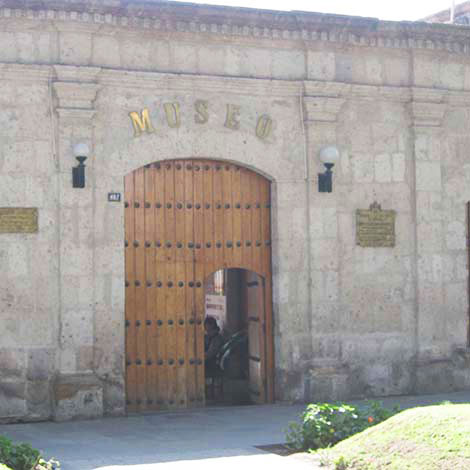
Just above Santa Catalina, the small, leafy Plazuela de San Francisco, usually buzzing with students and townspeople, is where you'll find Arequipas city museum, the Museo Histórico Municipal, which devotes ítseif principally to local heroes - army chiefs, revolutionary leaders, presidents and poets (including the renowned Mariano Melgar). It´s rather a dull collection of memorabilia, though some rooms have interesting photographs of the city. There are also displays of artifacts from the colonial period and the war with Chile. The university´s museums, located on the outskirts of the city, are of greater interest (see opposite).
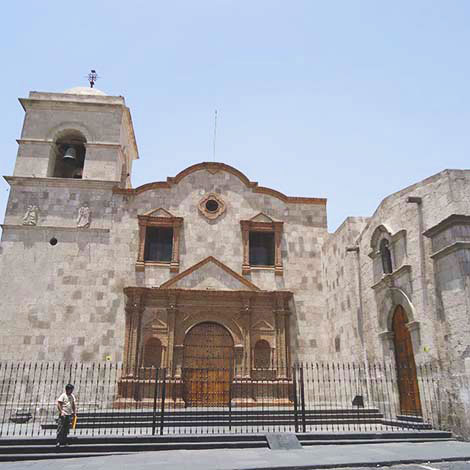
The Plazuela de San Francisco is home to a stríking Franciscan complex, dominated by a convent and the Iglesia de San Francisco. Yet another of Gaspar Baez's projects, this one dating back to 1569, it shows an interesting mix of brick and sillar work both inside and on the facade. Original paintings by Baltazar de Prado once covered the central nave, but the earthquake of 1604 destroyed these. However, the nave retains its most impressive feature - a pure-silver altar. Adjoining the church are rather austere convent cloisters and the very simple Capila del Tercera Orden, its entrance decorated with modest mestizo carvings of St Francis and St Clare, founders of the first and second orders.
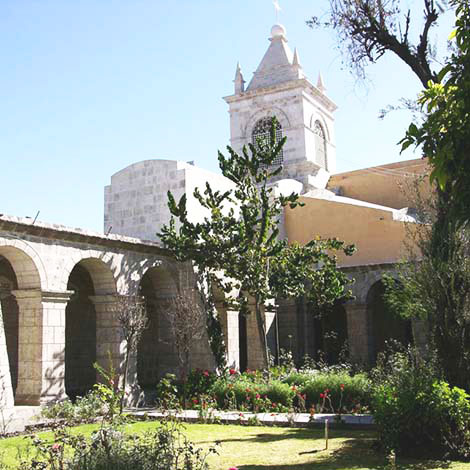
Close to the center of town, Monasterio de Santa Teresa is smaller than Santa Catalina but has astonishingly beautiful colonial patios set around a large open courtyard. Internally it has a colonial art museum that displays some fine religious artwork and murals, as well as twelve exhibition spaces and over three hundred works of art.
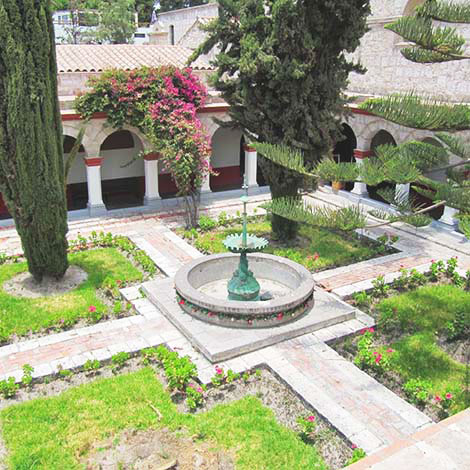
The Monasterio de La Recoleta is located on the western side of the Río Chili, which runs its generally torrential course through Arequipa from Selva Alegre, dividing the old heart of the city from what has become a more modern downtown sector, including Yanahuara (see opposite) and Cayma (see p. 164). This large Franciscan monastery stands conspicuously alone on Callejón de La Recoleta, just ten to fifteen minutes walk east of the Plaza de Armas.
The stunning major and mirror cloisters were built in 1651; in 1869 it was converted to an Apostolic Mission school administered by the Barefoot Franciscans. It is the archeology and natural history museums that really draw people here though. Open to the public since 1978, they house two rooms of pre-Columbian artifacts including textiles and ceramics; an Amazon room showing artifacts from jungle Indian tribes, and examples of forest flora and fauna; a religious and modern art gallery displaying both Cusqueña and Arequipeña classical works; plus a renowned history library with some 25,000 sixteenth- and seventeenth-century volumes.
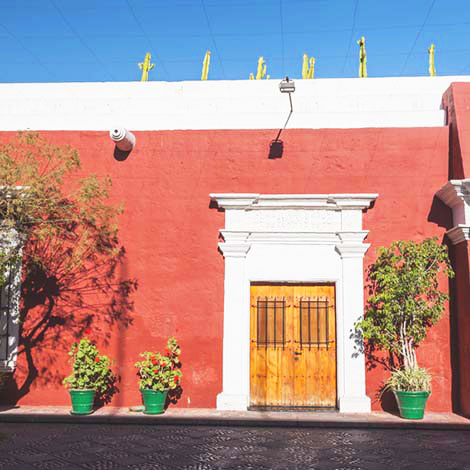
The Museo Santuarios Andinos, part of the Universidad Católica de Santa María, is arguably the most important museum in Arequipa today, with displays of some nineteen Inca mummies and a range of archeological remains; guides are obligatory but their fee, which is additional, is negotiable. The main exhibit is Juanita, the ancient 13-year-old "princess" uncovered in her icy ritual grave on September 8, 1995, by an expedition that included the archeologists Johan Reinhard and José Chavez, along with the well-known Andinista Miguel Zarate. Her gravesite, located at the incredible altitude of 6380m on Ampato Volcano, is estimated to be about 500 years old. It is thought that Juanita was sacrificed to the Apu Ampato and killed, after a time of fasting and herbal sedation, with a blow to the head by a five-pointed granite mace. The museum also contains fine examples of associated grave goods like textiles, precious metals, and Inca ceramics.
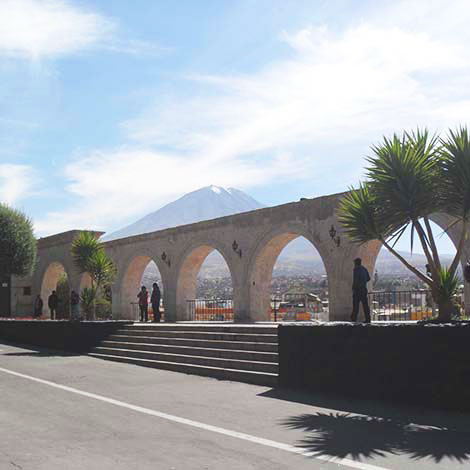
Until the railway boom of the late nineteenth century, which brought peasant migrants to Arequipa from as far away as Cusco, Yanahuara was a distinct village. It is now built up, though it still commands stunning views across the valley, above all from its churches. There are also one or two fine restaurants in this sector. The municipal plaza possesses a beautiful viewing point (mirador), which has been made famous by postcards.
To get here, buses and colectivos can be caught from the corner of Grau with Santa Catalina, or from Puente Grau, or it’s a fifteen-minute walk from Puente Grau (l-2km), between blocks 2 and 3 of Avenida Ejercito.
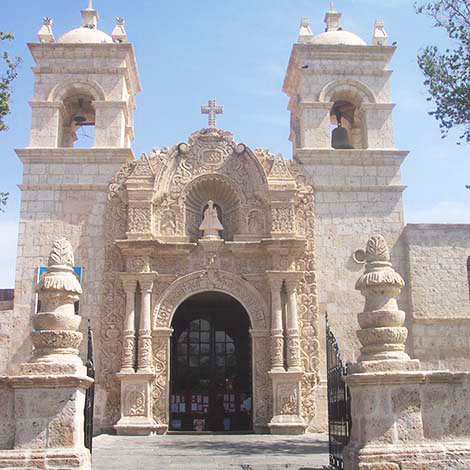
The small Iglesia Yanahuara on the tranquil main plaza dates to the middle of the eighteenth century, and its Baroque facade is particularly fine, with a stone relief of the tree of life incorporating angels, flowers, saints, lions, and hidden Indian races.
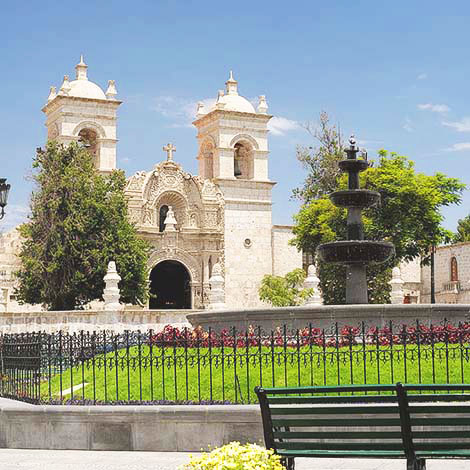
From Puente Grau, a longish stroll takes you across to the west bank of the Chili, along Avenida Ejercito, and out to the suburb of Cayma (3-4km); there are also buses available (see below). Another kilometer or so further out than Yanahuara, the area was once a small suburb with views over the city, but now reflects the commercial, even flashy side of Arequipa, with large shops and even one or two nightclubs. The suburb also offers good views of the Chachani Volcano.
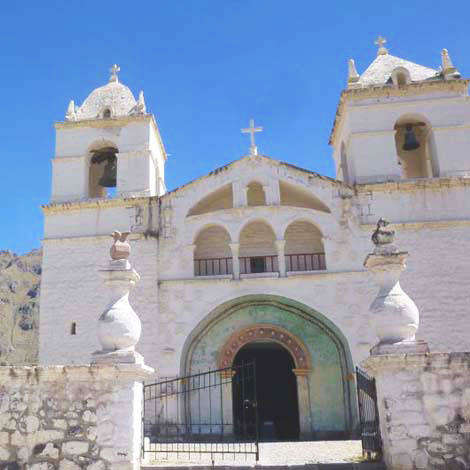
The Iglesia de San Miguel, buil in the early eighteenth century, houses an image of the Virgen de la Candelaria, donated to the city by King Carlos V. It’s possible to climb up to the roof of the church which offers great views across Yanahuara and towards the S volcanoes to the north.
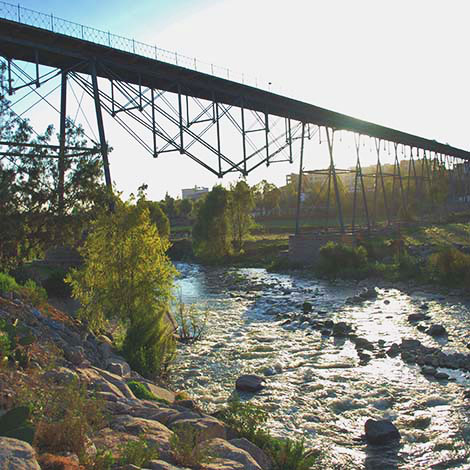
South of the city centre, Arequipa's very impressive black-iron viaduct, or Puente de Fierro, provides a great vantage point for views over the city to El Misti. Although spanning half a kilometer, it was well-designed by Gustave Eiffel and built to such high standards by die railway baron Henry May that it has successfully vaulted the city´s bubbling Río Chili, and. withstood the test of Arequipa severe earthquakes and tremors, for over a hundred years.
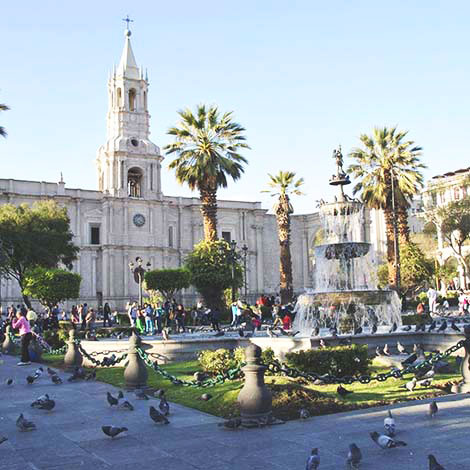
Arequipa's main plaza is a monument to the city's sillar architecture - white, muscular, and aesthetically unique. Impressive colonnaded balconies line three sides.
The fourth is given over to the cathedral, a humungous edifice with two soaring towers.
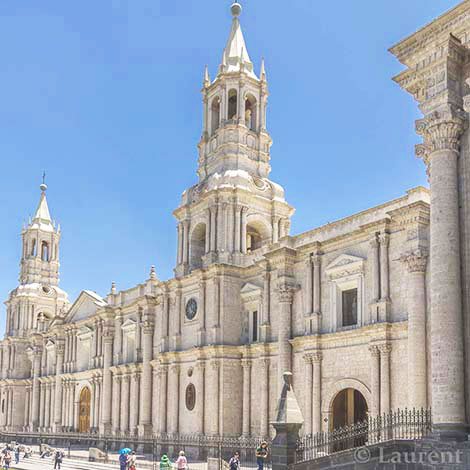
Originally built in the 17th century (and rebuilt many times since), the cathedral's luminous interiors contain 12 Italian marble columns (symbolizing the 12 Apostles) and a Byzantine-style brass lamp from Spain. In 1870 Belgium provided the organ, said to be the largest in South America - though damage during shipping condemned the devout to suince at its distorted notes for more than a century. It is the only cathedral in Peru that stretches the length of a plaza.
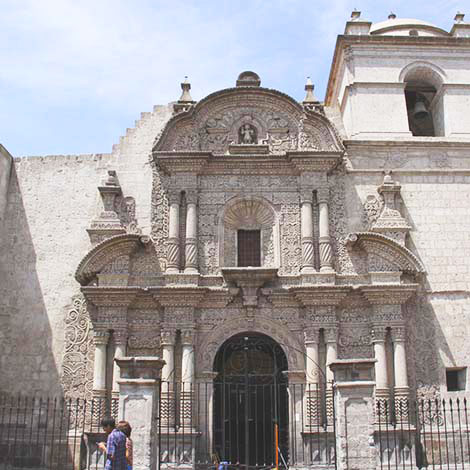
This diminutive Jesuit church on the southeast corner of the Plaza de Armas has a facade that is an intricately carved masterpiece of the churrigueresque style (think Spanish baroque - and then some). It has an equally detailed altar completely covered in gold leaf. To the left of it is the San Ignacio chapel, with a polychrome cupola smothered in jungle-inspired murals of tropical flowers, fruit, and birds.
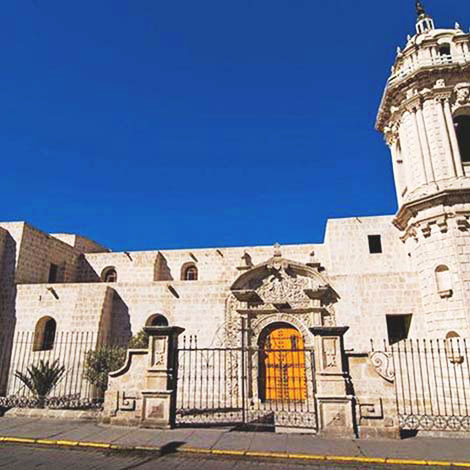
This gorgeous 17th-century Carmelite convent and museum is filled with priceless votive objects art, murals, precious metal works, colonial-era paintings, and other historical artifacts. A charming shop at the front of the complex sells baked goods and rose-scented soap made by the nuns.
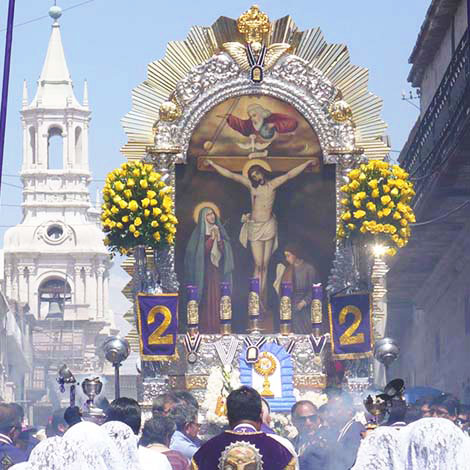
In the month of October, the people gather at San Agustin church to celebrate Purple Month. The celebrations center around Senor de los Milagros and the Virgen de la Nube. All month pictures of the Senor are carried around the town, churches, and hospitals for the holy month.
In the past the cultures of the Andes thought of the volcanos as powerful spirits that had total control of the weather and the crops. Today some still believe this to be the case, thinking the volcanos are both a protector and something to be feared. During the year at important festivals, offerings are made. There are treks to the volcanoes for those of you who dare.
The department of Arequipa has a grand history of some of the great artists, writers, and musicians coming from the district. The famous Peruvian author Mario Vargas Llosa comes from Arequipa as well as writer Mariano Melgar and other famous people including painter Carlos Baca Flor. Today Arequipa has many interesting museums, and galleries that testify to its artistic history.
Arequipa cuisine is a mixture of delicious spicy food and traditional Peruvian dishes. Try the local dicasteries for the best food in Arequipa.
Some recommended dishes are as follows:
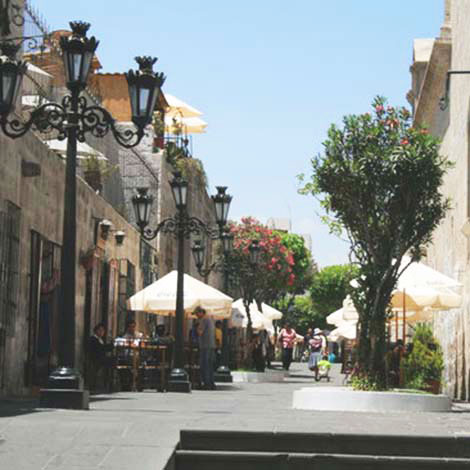
A UNESCO Cultural Heritage of Humanity Site, the center of Arequipa is one of the most beautiful in all of Peru. You will quickly see why the city is called the White City with most of the buildings in the center made from Sillar a volcanic stone from the area. Since the 16th century when Arequipa was built, it has seen a lot of volcanic activity from the nearby volcanos.
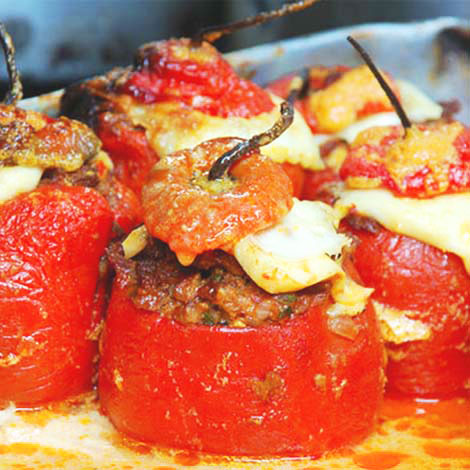
When you visit Arequipa and you tell the locals the first thing you will be asked is did you try the food. According to the people of Arequipa they believe that the food is the best in Peru. Don’t forget to try the Adobo, Rocoto Relleno, and Chupe de Camarones, but also if you get a chance try the Queso Helado for dessert.
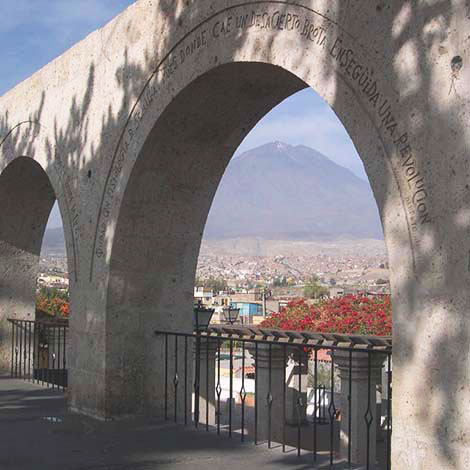
A lovely neighborhood that hosts a small tree-lined plaza leading to a “mirador” or lookout point. This viewpoint has exceptional views of the city and of its nearby volcanoes. The arches here are caved with quotes from Arequipa’s most prolific poets and writers.
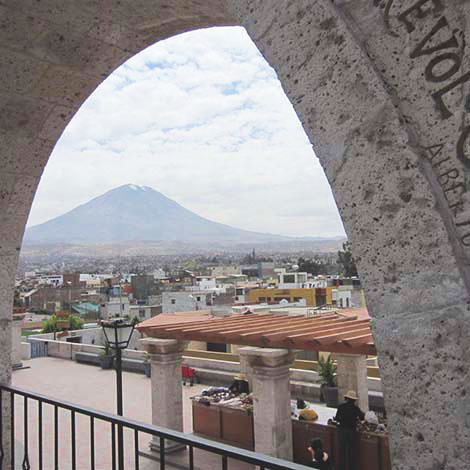
Go to the Yanahuara district overlooking the historic center to get fantastic angles of the majestic El Misti volcano. A beautiful terrace is framed by white stone arches carved with famous lines of prose and poetry in Spanish. It’s a great place to relax and soak in the views.
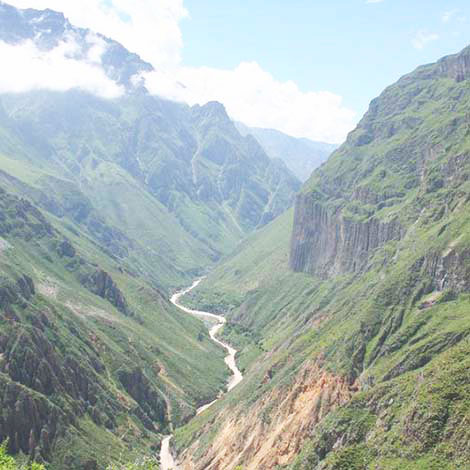
In most places you visit in Peru you will see alpaca products, like scarves, and sweaters on sale. If you get a chance to go to Mundo Alpaca you will get a lesson about alpaca products and the age-old technics of spinning. Learn to tell the difference between real wool and synthetic.
As it's not too far from the Pacific, the town's better restaurants are also renowned for their excellent fresh seafood. Picanterías - traditional Peruvian eating houses serving spicy seafood - are particularly well established here. There are also a number of non-picantería restaurants on the plaza, many of them with fine views to the Catedral and square below. Some also offer live musk, especially on weekend evenings.
Portal San Agustín 123. This fairly standard Italian-style café nonetheless serves some of the best and strongest coffee in Arequipa. The menu includes sandwiches, burgers and other fast foods, as well as full meals.
Portal de flores, Plaza de Armas. Upstairs and to the right of Cinesur, and linked to the luxurious Sonata Posada del inca, this café is located on one of only two sunny terraces on the east side of the plaza and serves fine sandwiches, pastas and main dishes. An expensive place to dine, but worth it, not least for the high-quality service.
C Jerusalen 407. Just below the corner of Jerusalen and Puente Grau, this café serves a large range of delicious pizzas, pastas and some meat dishes, all very good value. The walls are covered with the graffiti of travellers from every continent.
C Mercaderes 113. One of Arequipa's longest-established snack bars, offering good service and a delectable selection of meals, cakes and sweets, as well as excellent coffee. Portions are big and prices similar. There's another Manolos, newer but almost identical, just a couple of doors away on the same Street at number 117Restaurant Lakshmivan C Jerusalen 402. A very popular lunchtime vegetarian cafeteria at the back of a small patio, with a background soundtrack of classical musk and a tranquil afnbience. There's also a range of health-food producís, yoghurts and wholemeal bread for sale.
Pasaje Catedral 108. A small vegetarian snack bar in the lane behind the Catedral with good set menus, great yoghurt and scrumptious Mexican tacos. Prices are very reasonable, even if portions aren't overly generous.
San Francisco 216. Central, vaguely Middle-Eastern-themed place With excellent coffee plus crepes, sandwiches, sweets, and probably the best falafel in Peru; the space is popular and busy into the early hours.
C Tahuaytani 106, Sachaca. A notable, modern picantería located in a suburban district to the south of Yanahuara. Best at lunchtime when you can enjoy the shaded, spacious patios; everything is cooked over wood fires. Main-course prices start at S/20 per dish.
Alameda Pardo 123. Combining two of the finest restaurants in the city, this complex is based in the old Club Aleman, overlooking the city from the western banks of the Río Chili, with shady pagodas and a kids' play area. El Montonero is its excellent lunchtime restaurant, which is attempting to rescue some traditional regional dishes such as senca meatballs and pesque, which is made from quinoa with a cheese and steak topping. Che Carlitos is a relatively fancy Argentine grill and bar, serving excellent beef and alpaca cuts, but also offering fine salads and roast vegetables. Best at lunchtime.
Portal de flores 112. On the plaza but below ground level, this is one of the best meat restaurants in town with quite reasonable prices; try the grills or the lomo gaucho.
C Santa Catalina 120a. A highly recommended veggie restaurant with a distinctive atmosphere, serving excellent breakfasts, natural yogurt, juices, and mueslis plus very good and inexpensive vegetarian set meals. The restaurant is associated with the Centro Cultural Bhakti Yoga (in the same building), which offers daily classes.
Pasaje Catedral 113. Half-bar, half-restaurant, this serves good pizzas as well as other food (beef, chicken, pasta) in an often lively environment. There's also a dartboard (dangerously close to the front entrance), tables outside and just about enough room for musicians at weekends.
Tronchadero 404, Yanahuara. One of Arequipa's best-value picantería restaurants, specializing in traditional foods like guinea pigs and ricotto relleno and with fine views towards El Misti and the city from its patio garden.
Jerusalen 207, Yanahuara. Located in a different Calle Jerusalem (in the suburb of Yanahuara) to the one which bisects Arequipa's center, this place has tables set within and around attractive gardens, live musk, and superbly prepared, traditional Peruvian dishes, all enjoyed in a convivial atmosphere. It's quite expensive, with main dishes starting at around S/28, but worth the S/5 taxi out there; alternatively, it's a 15-minute walk over Puente Grau, then a few blocks up Av Ejercito. Cali to reserve a table, since it's very popular.
San Francisco 319. Quite a large, posh restaurant; pricey, but worth it for arguably the best Argentine-style steaks and grills in southern Peru, as well as the quality service.
San Francisco. A modern re-fit of an attractive cellar-vaulted space, this restaurant offers good Mediterranean-style food at average prices, with equally good service. Best appreciated in the early evening.
Rosal Restaurant This is an ecological restaurant run by environmentalists and situated in lovely gardens by the river. All the food Is delicious and organic, and their avocado stuffed with vegetables is exceptional.
Av Dolores 111. Probably the best picantería in town, this is the place to try your first cuy chactado or rocoto relleno. Opened in 1991 several blocks east of the city centre, it has a pleasant garden and is usually bustling with locals enjoying the extremely fresh and tasty food.
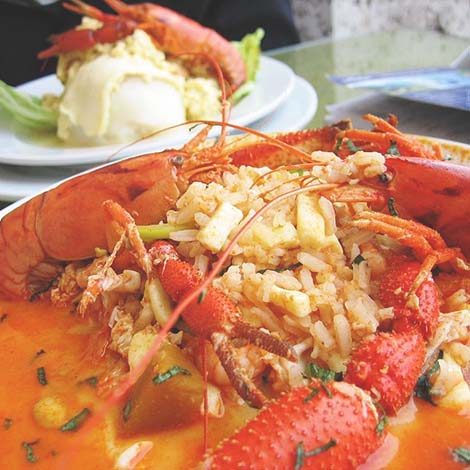
It's often hard to distinguish between bars, restaurants and nightclubs (or discos, as most are referred to), as many restaurants have a bar and live musk, while many bars and clubs also serve food. Welcoming peña restaurants concentrated along the streets between calles Santa Catalina and Jerusalen, specialize in more traditional music than either bars or clubs. Most peñas open Thurs-Sat 8.30pm-midn¡ght, while discos and nightclubs, many just a couple of Wocks from the Plaza de Armas, open nightly till 3 or 4am, and usually charge a small entrance fee (around S/10).
Adobo Typically eaten for breakfast In Arequipa. This is a pork dish where the meat and bones are soaked and cooked in maize-beer sediment or vinegar, onions, garlic, boiled small rocotos and chillis.
Cuy chactado The name comes from the flat, round stone – or chaqueria – which is placed on top of a gutted and hung guinea pig to splay it out flat in a large frying pan, while cooking it in ample olive oil; it is usually served with toasted maize and a sauce made from chillis and the herb huacatay (black Andean mint).
Chupe de camarones River shrimp casserole incorporating squashes, cheeses, chillis and potatoes.
Ocopa A cold appetizer that originated in this city but can be found on menus across Peru. iIt is made with potatoes, eggs, olives and a fairly spicy yellow chilli sauce, usually with ground peanuts added.
Rocoto relleno A spicy Andean pepper usually stuffed with minced pork meat and blended with garlic, tomato paste, eggs and mozzarella.
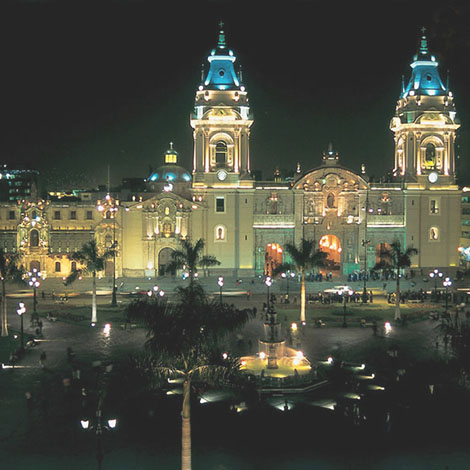
It's often hard to distinguish between bars, restaurants, and nightclubs (or discos, as most are referred to), as many restaurants have a bar and live musk, while many bars and clubs also serve food. Welcoming peña restaurants concentrated along the streets between Calles Santa Catalina and Jerusalen, specialize in more traditional music than either bars or clubs. Most peñas open Thurs-Sat 8.30pm-midn¡ght, while discos and nightclubs, many just a couple of Wocks from the Plaza de Armas, open nightly till 3 or 4 am, and usually charge a small entrance fee (around S/10).
C San Francisco 319. This small, popular place serves seafood, spaghetti, and meat dishes, plus, of course, drinks. There's also a big video screen and a nice rooftop patio, which can get crowded at weekends.
San Francisco 317. A popular restaurant in the Casona Forum complex, with reasonably tasty pizzas accompanied by good table service; the place usually gets very busy later on in the evenings.
Pasaje Catedral 107. A tidy Irish pub-type bar With a wide range of cocktails and whiskies, good rock music, and outside tables. Food was also served.
San Francisca 317. Popular with young locals and calling itself a "temple to rock'n'roll", this bar has a couple of decent pool tables and is decorated with posters of rock icons.
C San Francisco 317. The liveliest and funkiest spot in the city, with live rock-centric music on Fri and Sat. This massive venue boasts a concert hall and disco as well as a café, decent bars, and snacks.
C Jerusalen 522. Comes to life at night when excellent food is served amid live local folk music. Sometimes traditional folk dancing at weekends too.
C Santa Catalina 302 One of the larger and better venues in town, Las Quenas dishes out authentic Andean music, food (including breakfast) and good pisco sours. Live folk music most weekends (5/10 entrance), and also during the week from June to Sept.
C Jerusalen 522a. One of the main folk venues with music almost every night in high seaáon (S/6 entrance). AIso features traditional Afro-Peruvian music. Well frequented by Wur groups.
Portal San Agustín 105. Right on the Plaza de Armas and overlooking the angel fountain of the same name, this restaurant and peña has a great atmosphere when busy at weekends.
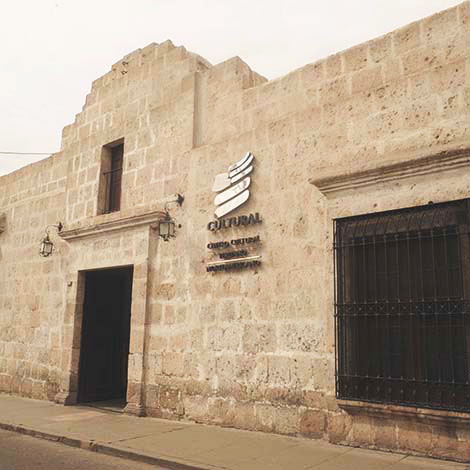 The cultural institutes put on occasional programmés, especially the Instituto Cultural Peruano-Alemán, (Ugarte 207, which has a cultural events notice board, shows good films in Spanish and Germán and sometimes has children's theatre. AIso worth a try are the Alianza Francesa, at C Santa Catalina 208, where there's a gallery displaying local artists' work, and the Instituto Cultural Peruano Norte Americano at C Melgar 109.
The cultural institutes put on occasional programmés, especially the Instituto Cultural Peruano-Alemán, (Ugarte 207, which has a cultural events notice board, shows good films in Spanish and Germán and sometimes has children's theatre. AIso worth a try are the Alianza Francesa, at C Santa Catalina 208, where there's a gallery displaying local artists' work, and the Instituto Cultural Peruano Norte Americano at C Melgar 109.
Arequipa's central market is one of the biggest and liveliest in Peru, though it's also a prime spot for pickpockets. located a couple of blocks down from Iglesia Santo Domingo, it sells all sorts of food, leather work, musical instruments, inexpensive artesanía and even llama and alpaca meat, while offering an excellent range of hats, herbs and even cheap shoe repairs. You can also get a selection of fruit juices, including some combined with eggs and dark, sweet, stout beer.
Artesanía, alpaca goods and silver jewellery can be found in a number of places, but mainly in shops along the Pasaje Catedral, close to the main plaza, and the stalls and shops around the courtyard at Centro Artesanal Fundo El Fierro, on the second block of Grau.
C Mercaderes 141, near the corner with Calle Jerusalen. A very plush, new shopping mall with a difference: quite upmarket in appearance, the products -- silverware, artesanía, clothing, quality food - are surprisingly inexpensive. On the second floor there's a very good internet service, cafetería and bar; on the third floor there's a museum of textiles from southem Peru.
For collections of colonial (and older) antiques, including some interesting pre-Columbian ceramics, the antiques and art shops at Puente Grau 314b and along blocks 1 to 4 of C Santa Catalina are excellent. Of the latter, the best is Arte Colonial, where there are several jam-packed rooms to explore.
C Jerusalen 120. The best baker in town, located at the back of a patio, where you can also sit down and eat breakfasts or snack. It also has a small delicatessen counter.
San Francisco 133. Sells a number of books in English and also has the best book-exchange service in Arequipa and a cultural events notice board.
C San Francisco 221. Stocks a wide range of English-language books, including many on the history and wildlife of Peru.
C Jerusalen 401b. Otherwise known as "Colca Trek" this shop offers camping equipment and maps plus a good range of tents, sleeping bags and all other essentials. lt is also a good place to enquire about expert guides.
C Santa Catalina 204. Has a significant range of camping and climbing equipment. There are other tour companies that rent out equipment, but not all are of the same quality.
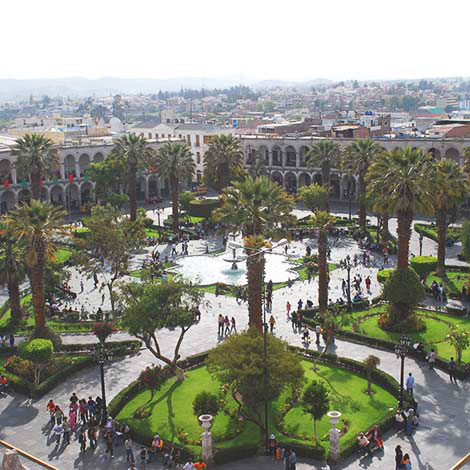
The region has a semi-arid and temperate climate. The rainy season begins in January and ends in March.
SEMI-ARID AND TEMPERATE
| Maximum temperature | Minimum temperature |
| 22°C | 5°C |
| 72°F | 41°F |
By air, The airport Manuel Ballon has flight to and from Lima, Juliaca and Cusco daily. Located around 8kms from the center of the city, take a taxi or book a transfer with your hotel.
By bus, with 2 major bus stations Arequipa is accessible to many destination all over Peru. For long distance travel from Arequipa always choose a safe company like Cruz del Sur, Oltursa or Exclusiva.
There are plenty of transport of options to get around Arequipa. Taxi are the easiest form of transport. Be care that they are registered and have an identification number. It is important to negotiate the fare before you enter the taxi. Also and mostly used by the local people is the Combis are frequent and easy to use. The cost is minimal but make sure you are getting on the correct bus.
It is a great idea to travel to Arequipa on your way to your high Andean destination, Arequipa is around 1000 meters below both Cusco and Puno. Most people do not experience altitude sickness in Arequipa, but if you wish to travel to the Colca Canyon the road reaches 4000 meters which effects many people.
The best time to visit Arequipa is from April to June. But having said that the weather is great all year round. During the busy months accommodation can fill quickly so book in advance.
In all of Peru´s highlands you will need to dress in layers, in the morning and at night it can get cold but during the day it is warms up and you can remove your layers.
Located in the South of Peru, Arequipa can be reached as you travel down from Paracas and Nazca. Arequipa is also the starting point for tours to the Colca Canyon. From here you can travel to Puno and Lake Titicaca. From Arequipa travel south to northern Chile. Many people also travel by bus or air to Cusco to visit Machu Picchu.